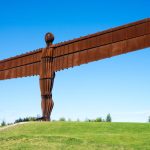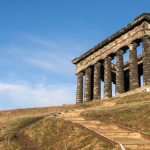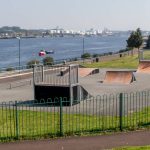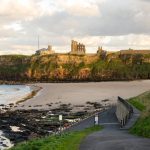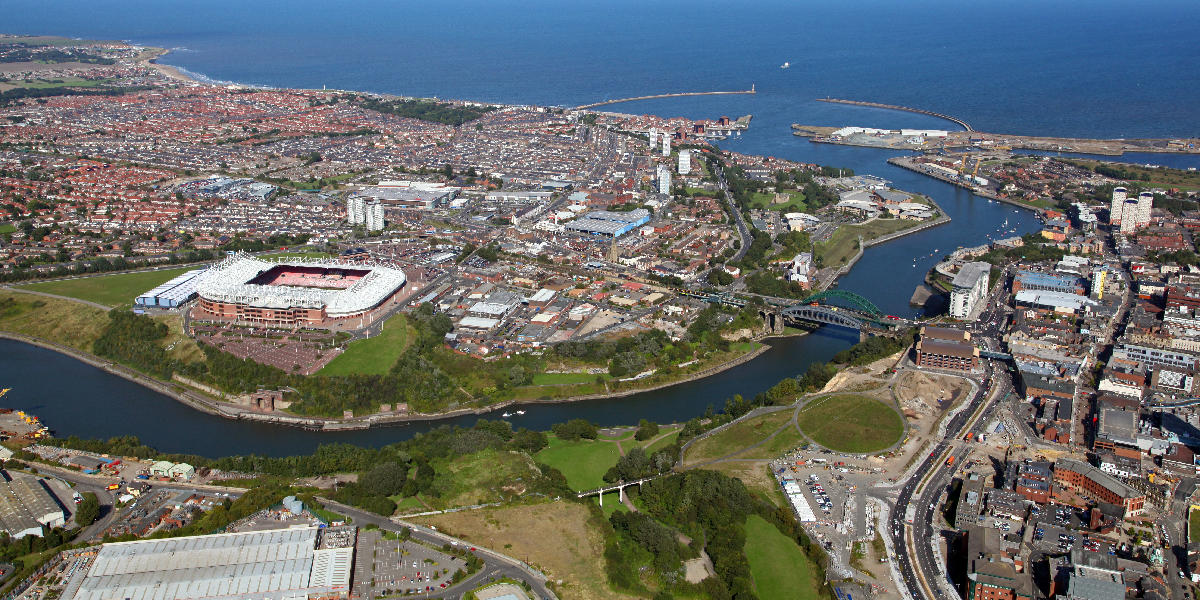
Sunderland is the city and metropolitan borough, in Tyne and Wear, north-east England, situated at the mouth of the River Wear. The city lies 10 miles southeast of Newcastle upon Tyne and 12 miles northeast of Durham. Sunderland has a long and proud industrial heritage, particularly in shipbuilding, glassmaking and coal mining.
A Fleeting History of Sunderland
Strong archaeological evidence, found on the outskirts of Sunderland at Hastings Hill, suggests that Stone Age hunter-gatherers settled the area somewhere between 4000 – 2000 BC.
Modern-day Sunderland grew out of three Anglo Saxon settlements that were situated at the mouth of the River Wear. On the north side of the River Wear, Monkwearmouth was settled in AD 674 when King Ecgfrith of Northumbria granted land to Benedict Biscop to found a monastery. It was in AD 674, that the Biscop invited French and Italian glaziers to the area to make the windows for the Monkwearmouth-Jarrow Priory. In AD 685, Ecgfrith granted Biscop further land, adjacent to the monastery, on the south bank of the river. Since the river separated the ‘new’ land from the monastic community, it was thereafter referred to as the ”sunder-land” (separate land). Bishopwearmouth, which was located to the west of the medieval village of Sunderland, developed from around AD 930 onwards. In 1179, Sunderland was granted a charter, by Hugh Pudsey, the Bishop of Durham.
In 1346, local merchant Thomas Menville started small scale shipbuilding in Wearmouth. By 1589, records show that Sunderland was producing salt panned from seawater on a relatively large scale. As coal was required in the drying process of panned salt, the local coal industry began to develop, simultaneously.
In 1642, came the English Civil War, between the king, Charles I, and parliament. Sunderland, like the rest of the North, sided with the king. In 1644, Cromwell’s allied forces, laid siege to the town, eventually forcing its surrender.
In 1719, the parish of Sunderland was created from the densely populated east end of Bishopwearmouth. A new church was also built in the newly created parish, i.e. Holy Trinity Church, (today, known as Sunderland Old Parish Church). Driven by the increasing success of the port and local industry, the influx of labour triggered a rapid increase in the local population. As a consequence, the three original settlements of Wearmouth, Bishopwearmouth, and Monkwearmouth, began to merge rapidly. In time, the town began to be known as ‘Sunderland-near-the-Sea’.
In 1796, Wearmouth Bridge was built across the River Wear, being only the second iron bridge in the world. The first being built over the River Severn at what is now the town of Ironbridge in Shropshire, which opened in 1781. However, while the Wearmouth bridge was more than twice the span of that at Ironbridge, it was only three-quarters of the weight. At the time of opening, it was also the world’s biggest single-span bridge.
In the late summer of 1831, Sunderland was the first place in the country to be struck by an outbreak of an ‘Indian cholera’ epidemic. The first victim of the disease, William Sproat, a keelman, died on 23 October. As a result, Sunderland was annexed by the government, seeing the port subsequently blockaded. However, by December the disease had spread to Gateshead, killing 50 people with a few days. From there, it rapidly spread across Britain, killing an estimated 32,000 people.
Following the Municipal Corporations Act of 1835, the Borough of Sunderland was formed. The Act paved the way for elected local government officials and local policing, as well as helping to minimise corruption.
In 1900, public transport was greatly improved with the arrival of an electric tram system. During the 1940s, the process began of gradually replacing the trams with buses. By 1954, the trams had been completely axed.
The outbreak of WWI led to a notable increase in shipbuilding throughout the northeast region. However, as a result of the town’s shipbuilding activities, Sunderland was targeted by the Germans. A Zeppelin raid on 1 April 1916, in the Monkwearmouth area, killed 22 people and injured numerous others. More than 25,000 men from Sunderland’s population of 151,000, served in the armed forces, during the first world war.
During the worldwide great depression of the 1930’s Sunderland’s shipbuilding industry, perhaps suffered its worst decline following the huge fall in demand after the boom of WWI. Sunderland shipbuilders, like others, had suffered regular fluctuations in demand for new ships or repairs throughout its history. In 1921, there were 15 shipyards in the Sunderland area, but by 1937, only 6 had survived. These yards went for a period of 4 or 5 years without launching a single ship. This depression had a greater impact on the industry than those previous, in as much as, fewer men now wanted to become shipbuilders and many left to join other professions. It followed on that in later years, there were fewer locally skilled workers and managers, around in the industry
The advent of World War II in 1939, saw Sunderland as a key target of the German Luftwaffe. The war claimed the lives of 267 people in the town, caused damage or total destruction to 4,000 homes, and devastated the local industry.
The Modern Era
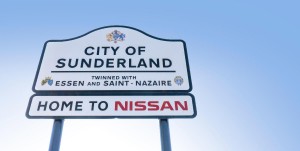
Image: Anthony McLaughlin/shutterstock.com
In the years immediately after WWII ended, a number of large housing developments took place in Sunderland, as the country embarked on a council house building programme. In 1967, The town’s boundaries were expanded, which saw the neighbouring wards of Ryhope, Silksworth, Herrington, South Hylton and Castletown, incorporated into Sunderland.
However, during the second half of the 20th century, the town’s two major industries, i.e. shipbuilding and coal mining, went into a steady decline. In 1978, there were more than 7,500 people working in Sunderland’s shipyards but this had fell t0 4,337 by 1984. The last shipyard closed in 1988, symptomatic of the decline in British shipbuilding in the face of international competition. It brought to an end, 650 years of shipbuilding in Sunderland. In December 1993, coal mining suffered the same fate, when the time was called on Sunderland’s last working pit, Monkwearmouth Colliery, after 158 years of operation. By the early 1990s, joblessness in Sunderland reached its peak, when up to 23% of the local workforce were unemployed, about 10% more than the national average.
However, it was during the 1980s and ’90s, that a number of new businesses, especially those in the service sector, came to Sunderland to establish themselves. In 1986, Japanese car manufacturer Nissan, opened its Nissan Motor Manufacturing UK factory in Washington, which has since gone on to become the UK’s largest car production plant.
On May 20, 1992, a civic delegation travelled from Sunderland to London for a historic audience with Queen Elizabeth II at Buckingham Palace. They received the Letters Patent, the documents which marked the official confirmation of city status for Sunderland.
In the early 1990s, regeneration projects began on the banks of the Wear, creating housing, retail parks and business centres, at the sites of the town’s former shipyards. The National Glass Centre, a museum, exhibition, research and cultural complex, opened in 1998. The University of Sunderland built a new campus at St. Peter’s, which also opened in the late 1990s.
The Stadium Of Light Opens
In 1997, another momentous event took place in the city, when Sunderland A.F.C.’s ground, Roker Park closed after 99 years. The club moved to its new home, a brand new 49,000 all-seater stadium, The Stadium of Light, which was built on the site of Monkwearmouth Colliery.
In 1999, Vaux Brewery closed with the loss of over 700 jobs. However, the upside was that 5.5 hectares of city centre land were freed up for redevelopment. However, after clearing the site, legal wrangling delayed the start of the construction works, until 2016. Since then, the liquidation of the main contractor has meant the further suspension of the works. The future of the site is still very much up in the air.
In 2007, Arc International moved their glass production from the Pyrex factory in Sunderland to France, ending commercial glass manufacture in the town which had existed since the 7th century.
At the time of the 2011 census, the city had a population of 174,286.
Places to see!
Sunderland has some great places to see, a few suggestions are:
St Peter’s Church
Those interested in history might want to pay a visit to St Peter’s Church. You’d probably be surprised to learn that it’s one of the UK’s first stone churches and there are archaeological remains dating back to as far as the 7th Century. It was founded by St Benedict Biscop in 674 AD and was later the home of the Venerable Bede. It has many original Anglo-Saxon features, including the tower and west wall.
National Glass Centre
The National Glass Centre is just across the street from St Peter’s Church. It serves to protect and tell the story of Sunderland’s 1300 years legacy of glassmaking. It’s free to visit, and you can attend free glass blowing demonstrations.
Sunderland Museum and Winter Gardens
To find out about Sunderland’s proud heritage and history, there’s no better place to visit than the Sunderland Museum and Winter Gardens. There are literally hundreds of different collections and exhibitions covering almost all aspects of the city’s past heritage, such as shipbuilding, glass and pottery making. The Winter Gardens is a tropical paradise with more than 2,000 types of plants.
Things to do!
Stadium of Light
If you’re interested in football, you could do worse than head to the Stadium of Light, home to Sunderland AFC. Currently (2021), in League One, the third tier of English football, the Wearside fans are known for their passion, so there’s guaranteed to be a great atmosphere at any home game. If you happen to be here when there isn’t a game, or even if you’re not a big footie fan, you can still take a guided tour of the ground. You’ll experience all the different aspects of the stadium, including walking down the tunnel and finishing off on the pitch.
Bridges Shopping Centre
Bridges Shopping Centre has over 90 different shops, including most of the best high street names, along with bespoke and specialist shops. You’re guaranteed to find almost anything you might be looking for, be it clothes, gadgets or home products.
Getting there and around!
Road
It’s fairly easy to get to Sunderland from all parts of the country if you are travelling by car. The most direct and easiest way to get to Sunderland from London and the south, and Edinburgh and the east of Scotland, is via the A1(M). However, you need to take the A1231 from the Washington Junction for about xx miles. The A19 brings you north to the city from Middlesbrough and most of Yorkshire. The A69 is the principal road link with Carlisle and the northwest, via Newcastle, along with the A1(M). The A690 links southwest to Durham and with the A1(M).
Rail
There are five direct trains daily, in each direction, between Sunderland and London King’s Cross. The journey takes about 3 hours. If you are travelling by rail from most of the rest of the country, then it easiest just to head for Newcastle. Changing there, you can complete your journey either by another train or the Metro. Trains run to and from Newcastle run every hour with a journey time of 20 minutes. You can also use Metro, which has trains every 12 to 15 minutes. There is also one direct train per day to and from Carlisle, taking around 2 hours.
Bus
The majority of bus services in Sunderland, and further afield to the likes of Durham and Newcastle, are provided by Stagecoach and Go North East, with a handful of services provided by Arriva North East. Go North East buses operate out of the Park Lane transport interchange. A Metro station underneath the bus concourse provides a direct connection with the Metro service. Inter-city bus routes, connecting Sunderland with the rest of the country, are operated by National Express and Megabus.
The Metro
The Tyne & Wear Metro is a light rail system that serves much of the region. The Metro consists of two lines; the Green Line and the Yellow Line. The Green Line runs between Newcastle Airport and South Hylton, via Newcastle city centre, Gateshead and Sunderland. Trains run every 12 to 15 minutes, with a journey time of 1 hour to the airport, and about 30 minutes to Newcastle Central Station.
Airport
Sunderland is accessible by air through Newcastle International and Durham Tees Valley airports. It takes approximately 1 hour on the local metro train from Newcastle International to Sunderland. Durham Tees Valley is about 37 miles from Sunderland, but would probably take more than 2 hours to link by public transport.
Where to stay?
Hotel: £60 – £80 (2 people sharing)
Lodge/B & B/Guesthouse: £40 – £60
Apartment/Holiday home: £80 – £120 (usually sleeping 2 – 6 people)
Try Our Sunderland Quiz
Quiz Maker – powered by Riddle
So there you have it our Five Minute Overview of Sunderland and a quick quiz to see if you were paying attention! Before you go why not try some of our other quizzes or have a look at some of our other location guides. better still why not join our growing community it’s free and could be very rewarding going forward.
